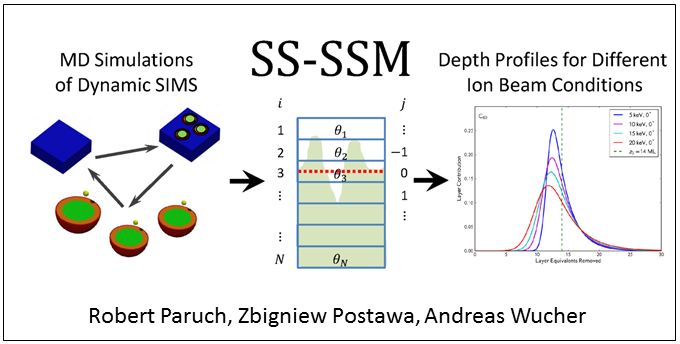Even though the divide and conquer simulations provide insight into the conditions of repetitive bombardment, there is insufficient material removed and the results are too noisy statistically to predict a depth profile of a delta layer. Following the development by our collaborators Kristin Krantzman and Andreas Wucher of the statistical sputtering model (SSM), we developed the steady state statistical sputtering model (SS-SSM) in order to interpret the results of the divide and conquer simulations. The essence of the model is to divide the system into layers. Kinetic equations are established for the ejection of material from each layer as well as displacements of material between layers. The input quantities for the model are taken from the molecular dynamics simulations using the divide and conquer approach. Solution of the coupled differential equations gives a predicted depth profile of a delta layer.
Application
The depth profiles for the simulation with and without sample rotation discussed on the Divide and Conquer web site provides an example for the SS-SSM calculations. Shown in the figure are the predicted depth profiles. The depth profile for the simulation with sample rotation is narrower and peaks closer to the position (14 ML) of the delta layer. Of note, is that the SS-SSM calculation does not explain why sample rotation works. For that, the pictures from the MD simulation are needed.
Observations
- Can define a total displacement yield, a quantity that depends on chosen layer thickness. The RMS roughness correlates with the displacement yield and not, for example, the crater size.
- Best depth profiles occur when the sputtering yield is large compared to the displacement yield such as grazing incidence vs normal angle incidence, C60 vs Au3
- The best measure of the delta layer position is the mean of the depth profile and not the peak position.
- The simulations on octane show that the larger irregular molecules have very small interlayer displacement values.
SS-SSM key publications
- Steady-State Statistical Sputtering Model for Extracting Depth Profiles from Molecular Dynamics Simulations of Dynamic SIMS , R. J. Paruch, Z. Postawa, A. Wucher, B. J. Garrison, Journal of Physical Chemistry C, 116, 1042-1051 (2012) 10.1021/jp2098075
- Partnering analytic models and dynamic SIMS simulations to interpret depth profiles due to keV cluster bombardment, R. J. Paruch, B. J. Garrison, Z. Postawa, Analytical Chemistry, 84 3010-3016, (2012) 10.1021/ac300363j
- Computed molecular depth profile for C60 bombardment of a molecular solid, R. J. Paruch, Z. Postawa, B. J. Garrison, Analytical Chemistry, 85, 11628-33 (2013) 10.1021/ac403035a This publication contains five animations.


